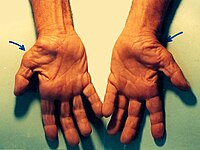
Photo from wikipedia
To compare ultrasound- (US), fluoroscopy- (FL), and palpation-guided contrast injection techniques used for dorsal radio-carpal wrist MRA. Patients with chronic wrist pain were randomized as to which injection technique they… Click to show full abstract
To compare ultrasound- (US), fluoroscopy- (FL), and palpation-guided contrast injection techniques used for dorsal radio-carpal wrist MRA. Patients with chronic wrist pain were randomized as to which injection technique they underwent into three groups of 50 participants. Dorsal radio-carpal contrast injection was performed under US, FL guidance (one radiologist for each), or palpation guidance by an orthopedic surgeon. The three techniques were compared by procedure time, success rate, number of attempts needed, frequency and grade of extravasation, joint distension, and MRA image quality. Additionally, any change from baseline wrist pain was recorded using the visual analog scale (VAS) at five time points (immediately, 8 h, 24 h, 48 h, and 1 week) after injection. One hundred and fifty patients (83 males and 67 females; mean age 29 ± 6.5 years) were included. Success rates for US- and FL-guided injections were 100%, while palpation-guided approach was significantly less successful (72%) (P = 0.02) with significantly more frequent extravasation (56%)(P < 0.001). US guidance was the least time-consuming (6.5 ± 1.6 min) compared to FL guidance (12.5 ± 1.9 min) and palpation guidance (8 ± 1.2 min) (all P < 0.001). The mean number of joint puncture attempts was significantly lower with imaging-guided techniques (1.1 ± 0.24 and 1.2 ± 0.4 for US and FL, P = 0.23) compared to palpation-guided one (1.6 ± 0.8) (P = 0.007). The largest increases in baseline-pain were 8-h post-injection, and US guidance was the least painful at all-time points (all P < 0.05). Joint distension and image quality were significantly better with imaging-guided techniques (P < 0.001 and P = 0.003). US-guided radio-carpal injection is a less time-consuming, more tolerable, and successful radiation-free method when compared to FL guidance. Palpation-guided injections require multiple attempts to enter the joint with high failure rates and frequent extravasation.
Journal Title: Skeletal Radiology
Year Published: 2021
Link to full text (if available)
Share on Social Media: Sign Up to like & get
recommendations!